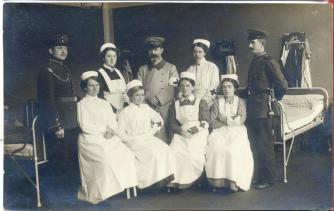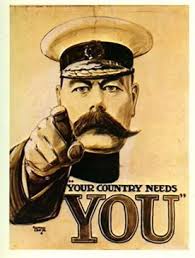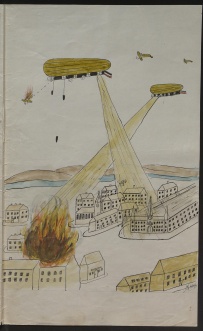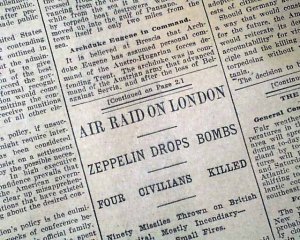
SOURCE B: A group of women who assisted as nurses during World War I. They are standing in a patients’ room. This source again shows that women did help during the war and that it wasn’t only the men who fought on the front line.

SOURCE C: A poster encouraging men to go and join the army. This has been used as it shows how much the army needed lots of men to join.

SOURCE D: A picture which a child drew at school showing the Zeppelin bombing. This shows that the war also had a major impact on the children living at the time.

SOURCE E: A white feather which the men, who didn’t go to war, had to wear. This feather was given to the men who didn’t join the army. They were considered as cowards.

SOURCE F: A mother and a child wearing gas masks. This shows how the children suffered during the war and how tough it must have been for them.

SOURCE G: A newspaper article on the Zeppelin Air Raid in London in January 1915. Innocent civilians died after this air raid and shows the impact of the war on the people.
WOMEN DURING WORLD WAR I
As seen is Sources A and B, women also played a role in World War I. In Source A, we see a woman working in an ammunition factory. A lot of the women worked in these factories. These factories provided weapons to the men who were fighting out in the trenches. In Source B, we can see women working as nurses during World War I. Many men got injured while fighting out at war. This making nursing a very important job during the war. Women also had to takeover the jobs of the men who were fighting in the war. This included jobs such as; bank clerks, ticket sellers, elevator operators, chauffeurs, street car conductors, railroad track walkers, block operators, draw bridge attendants. They also worked in machine shops, steel mills, airplane works, boot blacking and also worked as farmers.
HOW DID MEN WHO WERE NOT FIGHTING GET TREATED?
As we can see in Source C, men were encouraged to join the army and go out and fight at war. Though there were a lot of men who didn’t want to go out and risk their lives in battle. They were targeted by the people as being cowards. They chose to rather stay at home. They were targeted by the people as being cowards. As seen in Source E, these men were given white feathers and were often treated very harshly by the public. They were often refused service by shops and pubs.
CHILDREN DURING WORLD WAR I
Children were also impacted by the war. They had to deal with loss of family members and friends. Many children had to live without a father because most of the men were out fighting at war. The war was a disruption to home life and schooling for the children. In Source C, it shows a picture which a child drew at school. It shows the Zeppelin attack. This proves that World War I had a major on children.
CHALLENGES PEOPLE FACED DURING WORLD WAR I
Many challenges were faced during and after World War I. The people had to deal with the loss of friends and family members. People always had the fear of having an air raid on their hometown. The countries that were involved in the war had to pay for all the damages. Germany had to pay the most money towards all the damages that they caused. This caused a dramatic drop in their economy in the 1920s. The countries also had to pay money to the families of the casualties after the war.
ADVANTAGES TO BEING AT WAR
While at war, the soldiers would have saved a lot of money. This is because they wouldn’t have the same everyday expenses which they normally had. This included things like food, transport, clothing etc. With all the soldiers being away at war, the towns that the women and children lived in would have been much less crowded and would have given all the people a lot more space.
BIBLIOGRAPHY:
- http://www.historylearningsite.co.uk/home_front_1914_to_1918.htm
- http://www.bl.uk/world-war-one/articles/childrens-experiences-of-world-war-one
- http://www.history.com/this-day-in-history/first-air-raid-on-britain
- https://www.google.com/imghp?gws_rd=ssl

